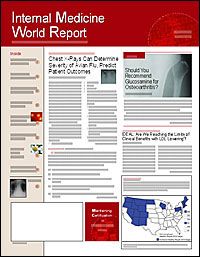A New Approach to the Diabetic Foot Accelerates Ulcer Healing
The diabetic foot ulcer presents a clinical challenge and can lead to major complications, including amputation. Data from a new study publi?shed in the Archives of Dermatology (2005;141:1373-1377) suggest that a short-term application of topical tretinoin (Retin-A) improves and accelerates the healing of foot ulcers in patients with diabetes and may offer another therapeutic option for this difficult-to-treat, yet common, condition.
Tretinoin, a synthetic derivative of vitamin A (all-trans retinoic acid), promotes cell division and differentiation and increases granulation tissue and collagen formation. When used before dermabrasion and other therapeutic procedures, topical ap?pli?cation of tretinoin has been shown to promote the healing of the diabetic foot, but the effects of this topical medication on open wounds have not been well documented to date.
"Topical tretinoin therapy may be a good addition to the already established methods of treating diabetic foot ulcers," wrote study investigators Wynnis Tom, MD, of the University of California, San Diego, and colleagues.
In this 16-week study, a group of 22 patients with diabetic foot ulcers were randomized to treatment with topical tretinoin 0.05% solution or placebo for 4 weeks. None of the patients had clinical evidence of lower-extremity peripheral arterial disease or infected ulcers.
Active treatment or placebo was applied directly to the wound bed and left in contact for 10 minutes every day, and then rinsed off with normal saline. After rinsing off the randomly assigned solution, the patients applied cadexomer iodine gel to the wound bed, which was left on until the next day. All patients continued to receive routine care for their ulcers.
Photographs and measurements of ulcer size were taken every 2 weeks after the patients started the assigned ?treat?ment, for a maximum of 16 weeks or until ulcer healing occurred. Primary end points were the proportion of ulcers that healed in each group and changes in ulcer size.
After the 12-week observation period, 46% of the ulcers in the tretinoin group and 18% of the ulcers in the placebo group healed completely (P = .03). The proportion of ulcers that demonstrated a >=50% reduction in ulcer size by the end of the study was 85% in the tretinoin group and 45% in the control group.
At the end of the 16-week study period, ulcer surface area decreased 54.7% in the tretinoin group and increased 2.7% in the placebo group. The difference be?tween the changes in ulcer surface area in the tretinoin and placebo groups was ?significant (P <.01).
Ulcer depth decreased 60.1% in the tre?tinoin group (P = .004 vs baseline) and 29.6% in the placebo group (P = .04) at 16 weeks. The difference between the changes in ulcer depth in the tre-tinoin and placebo groups was sig-nificant (P = .02).
Only 3 patients in the tretinoin group reported mild pain during the first few days of treatment, causing 1 patient to temporarily discontinue treatment. No local erythema, edema, or purulence or significant systemic effects were observed in the tretinoin group.
Decreases in ulcer depth and surface area occurred more quickly in the tretinoin group than in the placebo group, the investigators noted. Improved formation of granulation tissue was also observed in the tretinoin group.
